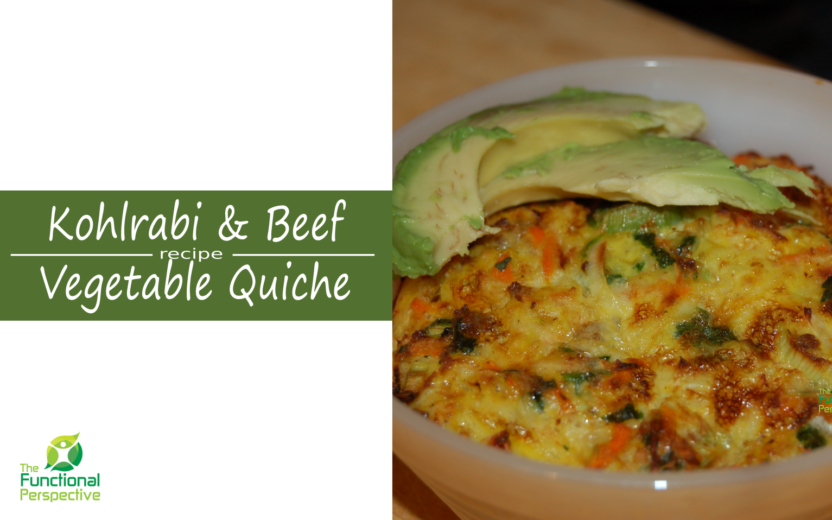Spectacular Kohlrabi & Beef Vegetable Medley Quiche

The weather has turned brisk which calls for warm delicious snacks. We had some kohlrabi that I needed to do something with so a quick search on pinterest and thus the inspiration for our afternoon snack!

Inspired by: Flavor and Savour
[/recipe-notes] [recipe-ingredients] – 2 Small Kohlrabi – grated
– 1 cup grated Carrot
– 1 small Leek
– 1 cup Baby Spinach leaves(before chopping)
– 13 Eggs
– 1/2 lb ground Beef (I used grass-fed)
– 1 1/2 tsp Salt (I most often use “Real Salt”)
– optional garnish: Avocado slices
[/recipe-ingredients] [recipe-directions] 1. Pre-heat oven to 375
2. Rinse and grate Kohlrabi, add 1 tsp of salt – mix well and sit aside while preparing the rest of the ingredients.
3. Brown the Ground Beef on medium low with 1/2 tsp Salt while preparing the rest. Remember to check for being fully cooked while preparing the other ingredients.
4. Crack eggs and mix well in large mixing bowl
5. Peel and grate Carrots – add to eggs.
6. Rinse and chop Leek – add to egg mixture.
7. Chop the Baby Spinach and add to the egg mixture.
8. Finish cooking the ground meat, if it is not done yet and then set aside in a small bowl to cool off a little before adding to the eggs.
9. With a cheese cloth or by another method – squeeze out as much water from the Kohlrabi as you can before adding it to the mixture. Then add to egg mixture
10. Add the Beef to the egg mixture.
11. Mix all of the ingredients together well. Be sure to stir from the bottom as the eggs will sink to the bottom of the mixture.
12. Spoon mixture into 3 individual large ramekins.(again making sure to get at least one spoonful from the bottom of the bowl. Place remainder into a quiche or small pie pan. Place ramekins on a baking sheet, optional for pie plate, and place in oven for about 45 minutes.
13.TIPS: Keep some ground beef cooked in your freezer in 1/2 to 1 lb packages, when you are in the need for a quick meal you can pull them out and make a casserole or simple quiche. When preparing leeks make one slice long ways and that will allow you to rinse any dirt that may get down in the lower layers, this also makes it easier to chop them by laying them on the flat side.
[/recipe-directions] [/recipe]
Beta cell regeneration – Hope for T1 Diabetics

I was at a wedding this evening and as our creator would have it my path crossed with another functional medicine minded individual with a Type 1 Diabetic family member! One of the tidbits I picked up from this blessed encounter was the role the spleen plays in beta cell regeneration.. So you all can probably guess one of the first things that I did upon returning home was head to the research portals to see what I could dig up.. Well this was the first one I came across (while I was munching on leftover chili)
Here is the abstract:
Approaches Towards Endogenous Pancreatic Regeneration
https://www.ncbi.nlm.nih.gov/pmc/articles/PMC1783561/
Banerjee M, Kanitkar M, Bhonde RR. Approaches Towards Endogenous Pancreatic Regeneration. The Review of Diabetic Studies. 2005;2(3):165-176. doi:10.1900/RDS.2005.2.165.
The phenomenon of pancreatic regeneration in mammals has been well documented. It has been shown that pancreatic tissue is able to regenerate in several species of mammal after surgical insult. This tissue is also known to have the potential to maintain or increase its β-cell mass in response to metabolic demands during pregnancy and obesity. Since deficiency in β-cell mass is the hallmark of most forms of diabetes, it is worthwhile understanding pancreatic regeneration in the context of this disease. With this view in mind, this article aims to discuss the potential use in clinical strategies of knowledge that we obtained from studies carried out in animal models of diabetes. Approaches to achieve this goal involve the use of biomolecules, adult stem cells and gene therapy. Various molecules, such as glucagon-like peptide-1, β-cellulin, nicotinamide, gastrin, epidermal growth factor-1 and thyroid hormone, play major roles in the initiation of endogenous islet regeneration in diabetes. The most accepted hypothesis is that these molecules stimulate islet precursor cells to undergo neogenesis or to induce replication of existing β-cells, emphasizing the importance of pancreas-resident stem/progenitor cells in islet regeneration. Moreover, the potential of adult stem cell population from bone marrow, umbilical cord blood, liver, spleen, or amniotic membrane, is also discussed with regard to their potential to induce pancreatic regeneration.
Did you catch that? Look at several factors which play a role in the regeneration…
“Various molecules, such as glucagon-like peptide-1, β-cellulin, nicotinamide, gastrin, epidermal growth factor-1 and thyroid hormone, play major roles in the initiation of endogenous islet regeneration in diabetes.”
Looks like I have the next few days cut out looking more in-depth as to what gets those things out of balance, what is needed to return those molecules to a homeostasis, what tests available to determine the status of those molecules in our system… my list will grow!
Anyway – just had to share as it’s another confirmation of hope for T1’s – when our perspective is changed from symptom management to system restoration our health takes on a whole new meaning! Hope you all are excited about our upcoming new year – I know I am! That’s it for now…
